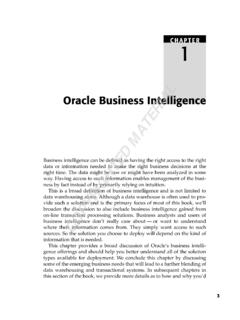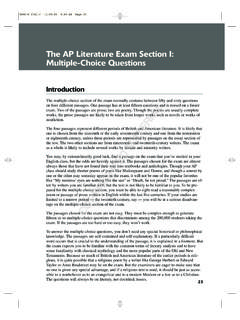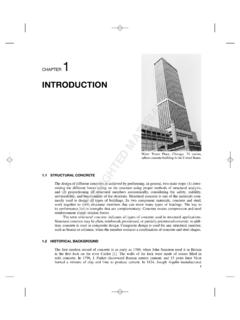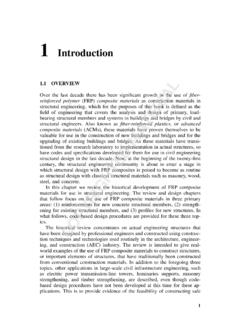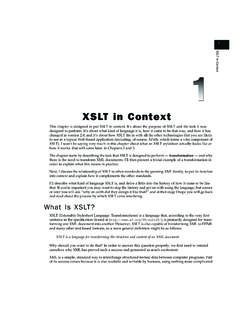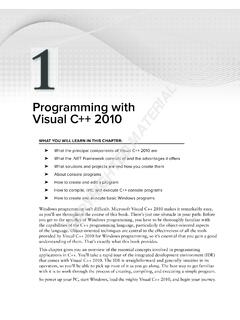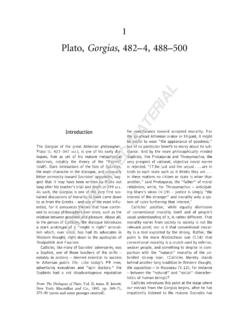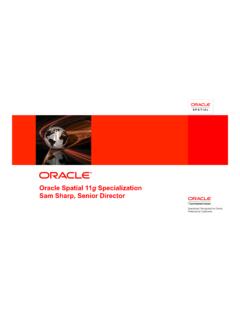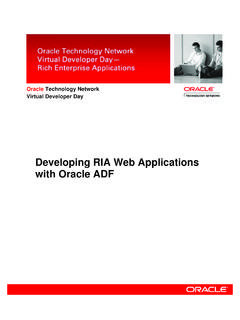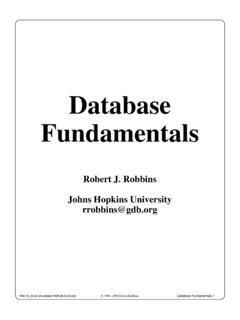Transcription of Chapter Using Oracle ASM 1 - John Wiley & Sons
1 Chapter 1 Using Oracle ASMOrAcle database 11g: ADMiniStrAtiOn ii exAM ObjectiveS cOvereD in thiS Chapter : database Architecture and ASM Describe Automatic Storage Management (ASM) NSet up initialization parameter files for ASM and database NinstancesStart up and shut down ASM instances NAdminister ASM diskgroups 11/28/09 9:43:39 AMCOPYRIGHTED MATERIALA utomatic Storage Management (ASM) provides a central-ized way to manage Oracle database disk storage. The Oracle database 11g OCP exam will test your knowledge of ASM, and thus ASM is the first topic we will tackle in this this Chapter , we will discuss what ASM is, how to configure an ASM instance, how to manage an ASM instance, and finally, how to use ASM from within an Oracle database . As is true in the rest of this book, we will conclude with a review of the Chapter , and we will tell you, in the section Exam Essentials, what you need to know about ASM for the exam.
2 Finally, we will present Chapter review questions and answers so you can determine whether you have gained sufficient knowledge of ASM to pass the Oracle database 11g OCP with the show!Exam objectives are subject to change at any time without prior notice and at Oracle s sole discretion. Please visit Oracle s Training and Certification website ( ) for the most current exam-objectives Is ASM?ASM is designed to simplify Oracle database storage administration. database environ-ments have become more and more complex, with large numbers of (and larger) datafiles, storage area networks (SANs), and high-availability requirements. ASM is somewhat like a logical volume manager, allowing you to reduce the management of Oracle files into ASM disk groups. It also provides redundancy configurations, rebalancing operations, and, when installed on top of clusterware, the ability to share database -related stores files in disk groups, which are logical entities made up of one or more physi-cal disk drives.
3 ASM is good for more than just storing database datafiles. In an ASM instance, you can store database datafiles, online redo logs, archived redo logs, backup files, and data-pump dumpfiles as well as change-tracking files and control files of one or several Oracle databases, though these databases and the ASM instance must have affinity to a given machine or cluster. ASM also provides the ability to locate the flash recovery area on an ASM disk group, so your backups to disk can be made to 21/28/09 9:43:39 AMWorking with the ASM Instance 3 Here are some features of ASM:Automatic software data striping (RAID-0) NLoad balancing across physical disks NSoftware RAID-1 data redundancy with double or triple mirrors NElimination of fragmentation NSimplification of file management via support for Oracle Managed Files (OMF) NEase of maintenance NASM fits perfectly into a Real Application Clusters (RAC) environment, but you can use ASM in a non-RAC environment too.
4 In the following sections we will cover these ASM-related topics: The ASM instance NConfiguring ASM disks NAccessing ASM from the database NManaging ASM NASM data dictionary views NYou should be aware of a few ASM limitations:ASM limits you to 63 disk groups in a given storage system. A disk group is a logical Nstorage entity that is made up of one or more physical disks (we discuss adding ASM disk groups later in this Chapter ). You can have a maximum of 10,000 ASM disks in a given storage system. NEach ASM disk can be a maximum of 4 petabytes (PB) in size. NEach ASM instance can manage up to 40 exabytes of storage. NEach disk group can contain up to one million files. NMaximum file sizes vary by the type of disk group: NExternal-redundancy disk group: 140PB maximum file size NNormal-redundancy disk group: 42PB maximum file size NHigh-redundancy disk group: 15PB maximum file size NWorking with the ASM InstanceDriving ASM is the ASM instance, which is a separate instance from any database instance.
5 The ASM instance is mounted but never open like an Oracle database . It is, essentially, just a bunch of programs (daemons) running. You will create only one ASM instance per node. You can use the Oracle database Configuration Assistant (DBCA) to create the ASM instance for you, or you can choose to create the ASM instance yourself. 31/28/09 9:43:39 AM4 Chapter 1 N Using Oracle ASMU sing ASM in the real WorldIf you are an Oracle database administrator, ASM will very much be on your mind if you have to deal with Oracle database clustering (RAC). Early on in the architecting process, you will have to decide how to store shared files because RAC depends on sharing of database datafiles among the different nodes of the have several options, including shared raw devices and vendor-supplied products.
6 Another option is ASM sitting on top of Oracle Clusterware. This combination can often provide a less-expensive solution over the vendor-supplied options and is easier to man-age than raw disk storage. ASM and Clusterware are very popular options, and it is likely you will encounter them in your Oracle very positive thing, from a business point of view, is that ASM is included as part of your Oracle database license. This makes Oracle Clusterware/ASM an attractive alternative to products from other vendors that charge extra for their clustering one location we are familiar with, the move to ASM was cautious but direct. Oracle Clusterware was installed and ASM was sitting on top. All new Oracle RAC installs started Using ASM instead of shared raw disk partitions. The flash recovery area (FRA) was also moved to ASM.
7 Older RAC databases were moved to ASM over time, and now all clustered databases are Using also note that Oracle s future direction calls for the elimination of raw devices for storage of database datafiles. This will make movement to an ASM solution even more the ASM InstanceIn the following sections, we will review how to create an ASM instance. First we will cover creating the ASM instance with the Oracle database Configuration Assistant. Then we will cover how to manually create an ASM the ASM Instance with the DBCAThe DBCA is a Java-based tool that you can use to create or remove Oracle databases. For-tunately for us, it can also be used to create or remove ASM instances. You can create the ASM instance at any time, regardless of whether a database already exists. In Exercise , you will see how to create an ASM 41/28/09 9:43:40 AMWorking with the ASM Instance 5exerciSe an ASM instance with the create the ASM instance with the DBCA, do the following:1.
8 Start the Oracle The DBCA presents a list of options for you to choose from. Select Configure Auto-matic Storage Management and click The DBCA then prompts you for the SYS password for the new ASM instance to be created. Enter the password for the SYS account. 4. Oracle then creates the ASM instance. A new window appears giving you the option to create new disk groups. You can choose to create disk groups (we will cover that shortly) or you can click Finish to complete the ASM The name of the resulting instance will be +ASM. You can log into the ASM instance from SQL*Plus, as shown in this example:C:\Documents and Settings\Robert>Set ORACLE_SID=+ASMC:\Documents and Settings\Robert>Sqlplus sys/Robert as sysasmSQL*Plus: Release - Production on Mon Jul 14 19:55:33 2008 Copyright (c) 1982, 2007, Oracle .
9 All rights to: Oracle database 11g Enterprise Edition Release ProductionWith the Partitioning, OLAP and Data Mining optionsSQL> select instance_name from v$instance;INSTANCE_NAME---------------- +asmWhen we logged into the ASM instance, we did so Using the SYSASM role. This role is much like the SYSDBA role when logging into a database and should be used when logging into an ASM instance for administrative the ASM Instance ManuallyManual creation of an ASM instance is fairly straightforward. If you have ever manually created a database , then manually creating an ASM instance should be easy for you. To manually create an ASM instance, you would follow these steps:1. Create directories for the ASM Create the instance parameter 51/28/09 9:43:40 AM6 Chapter 1 N Using Oracle ASM3.
10 Perform any Microsoft Windows specific Start the ASM Create the ASM server parameter file (spfile).Let s look at each of these steps in a bit more 1: Creating Directories for the ASM InstanceAn ASM instance is almost always called +ASM. An exception exists in RAC environments where the ASM instance will be called +ASM1, +ASM2, and so on. Create the admin direc-tories for the instance Using Oracle s OFA standards. In the following examples, we assume that you have defined the ORACLE_BASE following are examples of the commands you might issue:For Unixmkdir -p $ORACLE_BASE/admin/+ASM/bdumpmkdir -p $ORACLE_BASE/admin/+ASM/cdumpmkdir -p $ORACLE_BASE/admin/+ASM/hdumpmkdir -p $ORACLE_BASE/admin/+ASM/pfilemkdir -p $ORACLE_BASE/admin/+ASM/udumpFor Microsoft Windowsmkdir %ORACLE_BASE%\admin\+ASM\bdumpmkdir %ORACLE_BASE%\admin\+ASM\cdumpmkdir %ORACLE_BASE%\admin\+ASM\hdumpmkdir %ORACLE_BASE%\admin\+ASM\pfilemkdir %ORACLE_BASE%\admin\+ASM\udumpOf course, you could use a tool such as Windows Explorer to create the 2: Creating the Instance Parameter FileThe ASM instance will require a parameter file, just as any other Oracle instances does.
